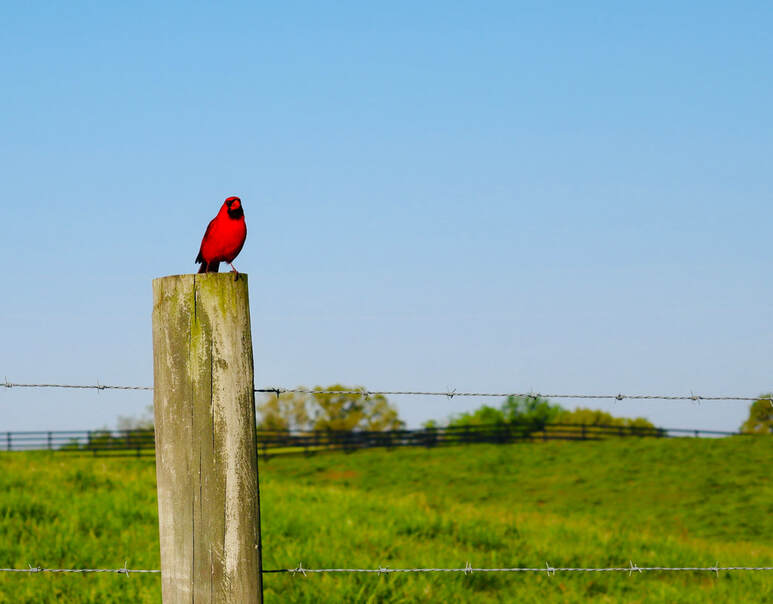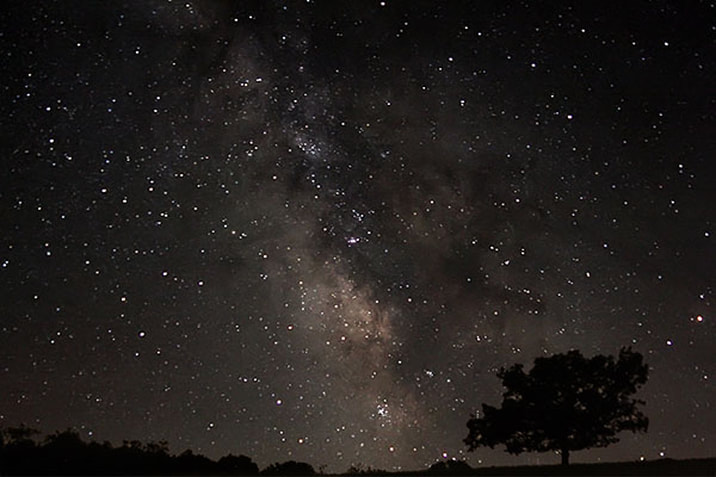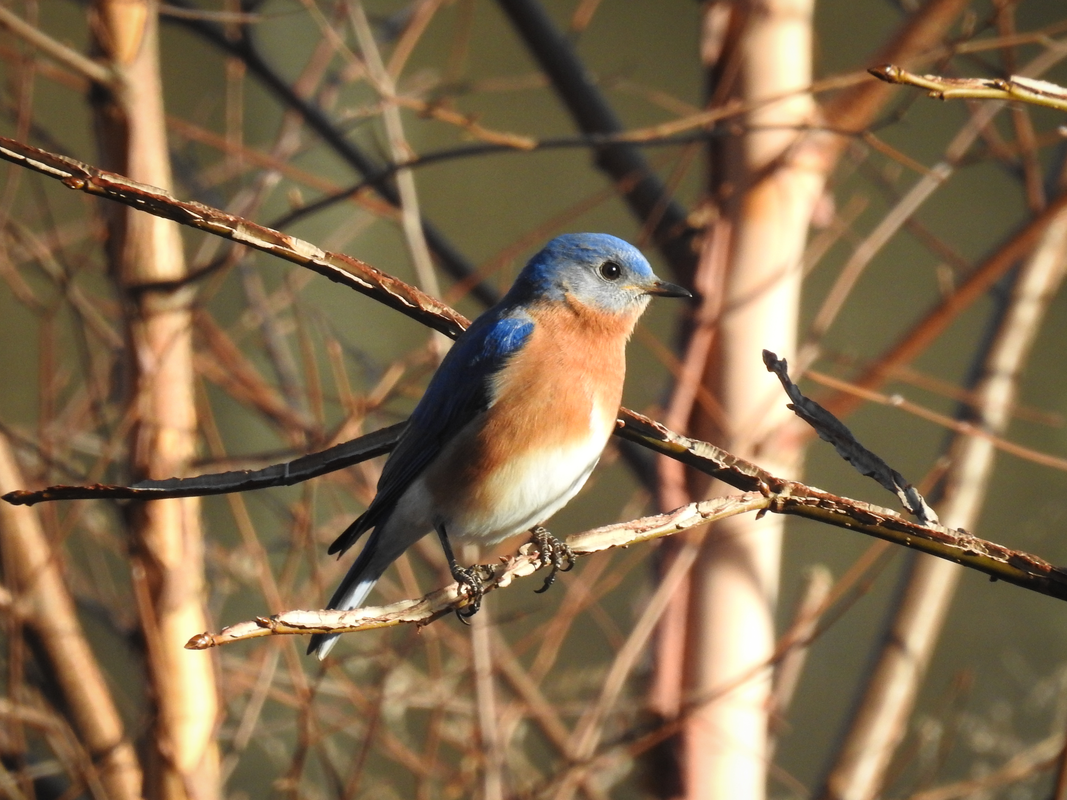|
Sycamore Grove Farm, Madison County We have a lot of cardinals on our farm. They are regulars at our bird feeders and also out in the field. I will often see 10 or up to 20 cardinals on my morning walk. The male’s bright color is truly eye-catching. Surprisingly comfortable around people, cardinals feed and sing within a few feet of you if you remain still and quiet. That makes them easy to observe up-close and admire the male’s brilliant red plumage and the interaction between the male and female birds. Besides being the State Bird of Virginia, the Northern Cardinal (Cardinalis cardinalis) is also the state bird of Illinois, Indiana, Ohio, Kentucky, North Carolina, and West Virginia. Not to be outdone by that alone, the cardinal is the mascot of two professional teams: the St. Louis Cardinals baseball team and the Arizona Cardinals NFL team. Cardinals are known by a lot of common names, including redbird, common cardinal, and red cardinal. An interesting thing about cardinals is that both the male and female sing. While 64% of female birds around the world sing, it’s more common in tropical areas. Cardinals are monogamous and stay together year round. Female cardinals sing as part of their strong instinct to defend their breeding territory. And females have more elaborate songs than males and may sing up to two dozen different tunes. During egg incubation (11 to 13 days), the male brings food to the female. Once the eggs hatch, the female varies her song to the male – either signaling the baby birds need food (“come to the nest”) or warning him not to come (she may have spotted a predator). Scientists have been able to isolate specific female songs and identify what she is trying to communicate to her mate. 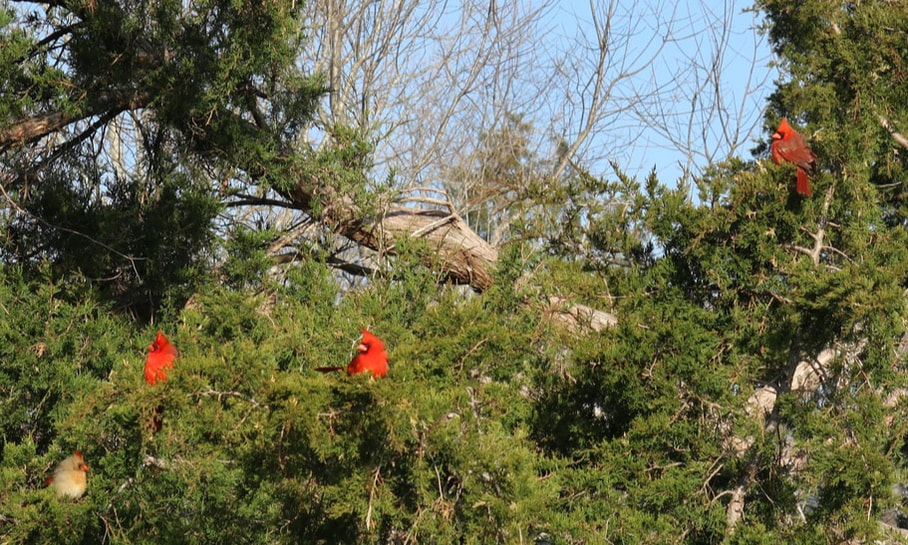 Cardinals perched in cedar bonsai; Credit: Charlene Uhl Cardinals perched in cedar bonsai; Credit: Charlene Uhl Here are some other interesting facts about cardinals:
Birding tip: For a list of bird identification books and apps, check out BIRDA (https://birda.org). BIRDA is a birdwatching app and community aimed at people who want to deepen their connection with nature and join a community that can support their interest in birding. Happy birding! Charlene Uhl
1 Comment
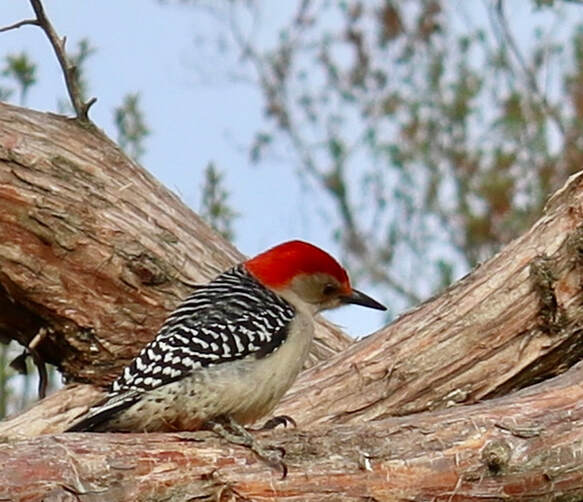 Red-bellied woodpecker; Credit: Charlene Uhl Red-bellied woodpecker; Credit: Charlene Uhl Sycamore Grove Farm, Madison County We have a healthy population of red-bellied woodpeckers (Melanerpes carolinus) on our farm. They regularly come to our bird feeder and can be seen flying over the farm throughout the day. One of their favorite places to land is on the electric poles that cross our property. I don’t think they are finding any insects in those poles but they have a good view of the open areas and surrounding trees. So why isn’t the Red-bellied woodpecker called a Red-headed woodpecker? After all, the last thing you notice on its belly is the slight rose blush. The story is that the red-headed woodpecker (Melanerpes erythrocecephalslus) was named first (and indeed its head and neck are bright red) so the name was already taken. The Red-bellied call is loud and frequently heard during the spring and summer. It could best be described as a loud trilling, descending in pitch. I love to research each bird I see on our farm: unique behaviors, their life span, what they eat, and aspects of their life. One of the things I found in researching the red-bellied is that it can stick out its tongue nearly 2 inches past the end of its beak. The tip is barbed and the bird’s spit is sticky (similar to a Pileated woodpecker), which allows them to snatch prey (primarily insects) from deep crevices in trees. I have seen them wedge nuts into crevices on top of one of our fence posts – then whack the nut into smaller pieces which they quickly consume. They are opportunistic feeders, eating berries, seeds, small invertebrates, as well as lizards, frogs, fish and bird nestlings. They even occasionally catch flying insects in the air. Like other woodpeckers, they may store nuts and seeds during the fall in crevices, to be eaten during the winter. The male red-bellied may excavate several holes, with the female selecting which one is completed and used. They may also use natural cavities, abandoned holes of other woodpeckers, or a nest box. In our area red-bellieds usually raise 2-3 broods each year. One of their major nest predators are European starlings (Sturnus vulgaris). Scientists have found that as many as half of all red-headed woodpecker nests in some areas get invaded by starlings. The life span of woodpeckers ranges from 4 - 11 years. The oldest known Red-bellied lived to over 12 years and was identified in the wild by his band. Birding tip: Birds are most active between dawn and 11 am. This is particularly the case in spring and early summer, when birds sing in the early morning. So get out there before your breakfast and you’re bound to see more birds than after lunch! Happy birding! Charlene Uhl 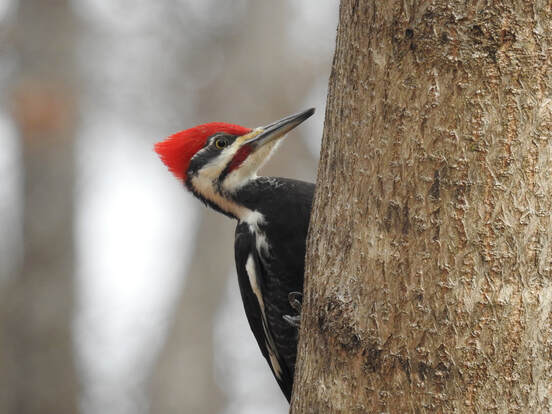 Pileated woodpecker; Photo: Deanne Lawrence Pileated woodpecker; Photo: Deanne Lawrence Sycamore Grove Farm, Madison County The Pileated woodpecker (Dryocopus pileatus) is the largest woodpecker in North America. We have several on our farm and they are amazing to watch in flight. Their exaggerated swooping and their large body make them easy to identify. But they are not related to pterodactyls – they just give that impression with their size and “jack-hammer” approach to bug hunting. These woodpeckers live in Virginia year-round and, unlike most other birds, they will defend their territory all year as well – not just during breeding season. According to Birds of North America (an amazing publication of The Cornell Lab of Ornithology), Pileateds prefer an oak-hickory forest with mature stands of dense vegetation near the ground. They have a long-extensible, pointed tongue with barbs and sticky saliva. They use their tongues to extract ants from tunnels in rotting wood. A pair of pileated woodpeckers needs a large amount of land – around 150 acres or more – to raise their young. The Pileated, like most woodpeckers, nest in hollow trees or vacated nest cavities. They excavate only the entrance hole to gain access to the hollow interior of a tree. They often have multiple entrances holes, so they have an escape route if a predator enters the roost. We have not seen the Pileated’s nest site on our farm yet but we know it is in a heavily wooded area in a steep ravine at the back of our property. They play a vital role in forests like the one adjacent to the north side of our farm. They excavate large nesting, roosting and foraging cavities that are then used by all sorts of other birds and mammals. That can include wood ducks, bats and flying squirrels. Scientists have noticed that Pileated woodpecker numbers increase in areas with widespread emerald ash borer, an invasive beetle that kills ash trees. That could mean that these woodpeckers could be one of the strongest lines of defense to control non-native forest pests. So leave those dead and dying trees out there for these wonderful woodpeckers. They’ll improve the habitat and attract all sorts of wildlife to your property. Birding tip: You can often tell the difference between a Pileated and other woodpeckers by their drumming, without even seeing it. Most woodpeckers drum at a steady pace. A Pileated drums slowly, accelerating and then trailing off. And as Audubon notes, “their loud, escalating shrieks bring to mind a maniacal laugh. " So true! Happy birding! Charlene Uhl 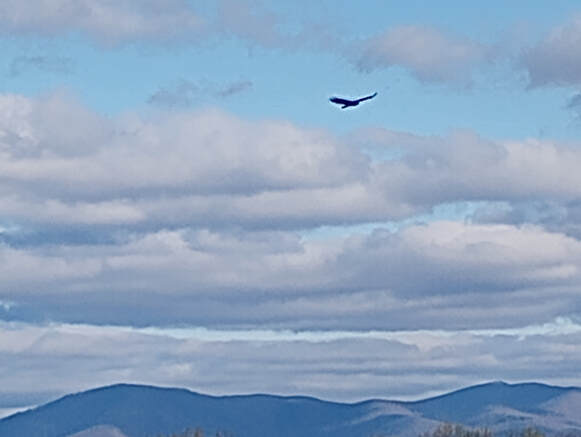 Turkey vulture (Cathartes aura); Photo: Charlene Uhl Turkey vulture (Cathartes aura); Photo: Charlene Uhl Sycamore Grove Farm, Madison County You have probably seen a turkey vulture (or two or three) on the side of the road, eating “road kill," AKA carrion. You might have also seen them soaring in the sky, looking for a meal. These birds and their cousins - the black vulture – play a very important role in the natural world. They truly are nature’s cleanup crew. On my daily bird walk, I don’t always see vultures. I wondered about this and then realized that they conserve energy by soaring. They rarely flap their wings. Since I walk fairly early in the morning, the air is often still. But on those mornings when the wind is up, I can count on seeing turkey vultures, who are taking advantage of the air thermals coming down from the mountains. They have extremely well-developed eyesight. As I researched them a little more, I was fascinated to learn that they first detect freshly rotting meat with their nose: they have been known to smell carrion from over a mile away. I also found out that our farm is the ideal habitat for vultures: they are found in relatively open areas (our hay field) near to woodlands, which are important for both nesting and roosting. But they’re certainly not limited to our farm in their daily search for food. Turkey vultures can travel up to 200 miles in a single day. While a vulture’s feet can’t be used to kill prey, like those of a hawk or eagle, their beaks are strong enough to rip through cowhide. But they like their meat fairly fresh. Apparently by the fourth day they will not feed on carrion because the meat is too rotten. So that’s why we’ll sometimes see a partially eaten carcass of a deer or other large animal alongside of the road. Guess that extraordinary sense of smell has another purpose! The Chattahoochee Nature Center has a fascinating web page on turkey vultures with even more information about their abilities. So when we see the cleanup crew at work, we can be thankful for the great job they are doing! Birding tip: Did you know that the five keys to bird ID are size, shape, color pattern, behavior and habitat. When you’re out birding, try to make it a practice to mentally recognize those five aspects of each bird you see. It very quickly becomes a habit and you’ll be able to identify a lot more birds – and know what birds to expect in the habitat you’re in. Happy birding! Charlene Uhl  Northern mockingbird (Mimus polyglottos) on garage rooftop; Photo: Charlene Uhl Northern mockingbird (Mimus polyglottos) on garage rooftop; Photo: Charlene Uhl Sycamore Grove Farm, Madison County Following up on last week’s Bird Blog on blue jays, I wanted to share Atticus Finch’s quote on mockingbirds: “It’s a sin to kill a mockingbird,” Finch tells his daughter Scout. “Mockingbirds don’t do one thing but make music for us to enjoy. They don’t eat up people’s gardens, don’t nest in corncribs, they don’t do one thing but sing their hearts out for us.” While this doesn’t totally exonerate Finch for his statement about blue jays, it does capture the special essense of the Northern Mockingbird (Mimus polyglottos). Every year since we moved into our house here in Madison County, we have had a pair of mockingbirds that own the immediate land around the house. The male mockingbird begins singing early each morning in the spring. He has several favorite perches, including the weather vane on our barn, the peak over our garage and the two large holly trees on the east side of our house. He will frequently fly straight up from his perch, then back down – all the while singing loudly. He moves from one perch to another to another, singing a lovely medley of songs – and sometimes I think I actually recognize which bird he is mimicking (or not). Mockingbirds also mimic other sounds, including crickets, cats and even sirens! Once our pair of mockingbirds builds a nest, they actively chase other birds away. And they are very territorial overall – scientists and other birders have observed them attacking predatory birds, even bald eagles, when their territory is invaded. Stan Tekiela describes their mating behavior perfectly in Birds of Virginia: “Very animated, male and female perform elaborate mating dances by facing each other, heads and tails erect. They run toward each other, flashing white wing patches, and then retreat to nearby cover.” Birding tip: Mockingbirds eat seeds, insect, bugs and worms – and they will definitely visit your bird feeding area if you put out suet. But unlike woodpeckers, the mockingbird can’t hang upside down on the suet cage so they will perch on top of the feeder to have a snack. Happy birding! Charlene Uhl Sycamore Grove Farm, Madison County To Kill a Mockingbird was one of my favorite books, as well as the movie rendition. All except for that horrifying quote that Atticus Finch said to his son Jem who was just learning to shoot: “I’d rather you shot at tin cans in the backyard, but I know you’ll go after birds. Shoot all the blue jays you want - just don’t kill a mockingbird.” Blue jays have been reviled and persecuted by many different groups over the years. In Native American lore, blue jays are portrayed as thieves and tricksters. Their behavior has definitely contributed to their reputation: blue jays are known for marauding other birds’ nests, being bullies at your backyard bird feeder, and generally having an aggressive attitude. I have seen this behavior on our farm. They are frequently grouped with European starlings as “nuisance” birds. But they play an important role in the bird world. Stan Tekiela, author of Birds of Virginia Field Guide, says jays are “known as the alarm of the forest, screaming at any intruders in the woods.” I have seen this behavior, too. Red-shouldered and Cooper’s hawks frequently come to my bird feeding station, attracted to the numerous “meals” they observe. Jays are vociferous and loud when they spot one of these predators. There is a sudden mass exodus from the ground where birds were eating seed into the trees for shelter. So I am glad that the birds I bring seed to each morning have a protector in jays. Joan E. Strassmann tells one of the best stories about blue jays in her Slow Birding book mentioned in an earlier bird blog. She points out oak trees are beholden to jays for spreading their fruit (acorns) far and wide. These trees rely on birds to be the major distribution agent, often carrying the acorns miles away from their parent tree. Scientists studying jay behavior found that these birds collected acorns, stored them in their mouth and throat, flew to a common cache area and buried them tip-first in holes so that each hole held only one acorn. While some were eaten, many acorns grew into trees. “When I hear that the Blue Jays have found a roosting owl or have become alerted for some other reason and fly through the neighborhood with their screeching warning,” Strassman notes, “I like to remember that they have airlifted the oak trees north in tiny acorn packages as the glaciers retreated.” Birding tip: Audubon offers a wonderful online resource: Bird Watching 101: A Guide for Beginners. Even experienced birders will glean some ideas on how to improve their birding techniques. Happy birding! Charlene Uhl The little things that we do every day have a huge impact on our natural world. It makes sense that native plant enthusiasts care about invasives, clean water, soil health, the warming climate, more intense weather patterns, even clean air…but what about dark skies?
Dark skies affect multiple natural processes. For example, many crops are dependent on insect pollination. If you like to eat, you care about insects and in turn, also dark skies. Insects also serve as a food source for many species. If you care about birds, you care about insects and also in turn, dark skies. Why should we do something about light pollution? Humans “around 80 percent of all—and more than 99 percent of people in the US and Europe—now live under light-polluted skies. In addition to direct lighting from urban infrastructure, light reflected from clouds and aerosols, known as skyglow, is brightening nights even in unlit habitats.” (Kwon, 2018) Many, truly do not know what unlit skies look like. In addition, insects are impacted by light pollution. The article “Light Pollution is a Driver of Insect Declines” discusses how artificial light serves as an evolutionary trap. Artificial light is a human-induced problem. Throughout ecological history, “most anthropogenic disturbances have natural analogs: the climate has warmed before, habitats have fragmented, species have invaded new ranges, and new pesticides (also known as plant defenses) have been developed. Yet for all evolutionary time, the daily cycle of light and dark, the lunar cycle, and the annual cycle of the seasons have all remained constant. insects have had no cause to evolve any relevant adaptations to artificial light at night.” (Avalon et al, 2020) Insects are attracted to the ultrabright unnatural lights and exhaust themselves before engaging in pollination or reproduction. The decline of insects lead to diminished food sources for larger organisms. Light pollution causes disorientation and exhaustion in migratory birds. Birds use energy stores to make long journeys. Studies show that “migrating birds were disoriented and attracted by red and white light (containing visible long-wavelength radiation), whereas they were clearly less disoriented by blue and green light (containing less or no visible long-wavelength radiation).” (Poot et al, 2008) The good news is that humans can put ecological practices in place to mitigate the impacts of light pollution. Further research shows that “artificial light at night impacts nocturnal and diurnal insects through effects on development, movement, foraging, reproduction, exhaustion and predation risk.” (Borges, 2022) It is estimated that light pollution is driving an “insect apocalypse” resulting in a loss of around forty percent of all bug species within just a few decades. There are multiple reasons to care about insects. We can make an impact on this serious problem. Community members can have their voices heard by participating in their local HOA meetings and completing surveys conducted by the local government in the comprehensive planning phase. By speaking out residents can weigh in on light ordinances in public spaces. Even talking to neighbors who are unaware of the problem can help. The International Dark Sky Association (https://www.darksky.org/) has great resources for educating yourself and others about light pollution. Virginia has five Dark Sky parks which are more than any other state East of Mississippi. The parks include Rappahannock County Park, Sky Meadows State Park, Staunton River State Park, James River State Park, and Natural Bridge State Park. The link to the parks can be found at https://www.darksky.org/our-work/conservation/idsp/finder/. Visiting Dark Sky parks and taking part in citizen science is an important way to help protect these amazing spaces for future generations to enjoy. Sycamore Grove Farm, Madison County If you’re like me, you are wondering where are all the robins coming from lately? I occasionally observe (or hear) one or two robins on my daily morning bird walk during the winter. But in the last week and a half they are arriving in droves. Two days ago I counted 150 robins within 300 feet of our house. On this morning’s bird walk I counted 75. They fly down into the grassy area and hop around, looking for something to eat. The back story is that most Virginia robins don’t migrate - they spend their entire winter in their breeding range here. The reason we don’t see them is they simply move into the nearest woodlands, finding worms, grubs and insects in spots where the ground remained open and unfrozen. Robins also eat a wide variety of berries remaining on bushes from the fall. The robins we are seeing in big flocks now are the robins that did migrate south. These are probably male robins which are returning to their breeding grounds up north to stake out territory. The migrating female robins arrive a little later – from a few days to around two weeks. Our resident robins will become more visible as the weather warms up a bit, typically around April. Their mating season runs through July. American robins are one of the first birds to begin laying eggs each spring. They normally have two or three broods each season. The average life span of a robin is two years (remember a dark-eyed junco’s longevity averaged 11 years). They have a lot of predators, including other birds (crows, ravens, hawks, owls and eagles); mammals (squirrels, raccoons, foxes, and wild and domestic cats); and reptiles (rat snakes, gopher snakes and snapping turtles). In her book Slow Birding: The Art and Science of Enjoying the Birds in Your Own Backyard, Joan E. Strassmann shares the findings of two Canadian professors on “How Robins Find Worms.” The scientists determined that “the birds were initially locating worms by hearing, then tilting their heads back to focus their foveae [the sharpest, central part of the eye] on the spot where they first heard the worm.” Using this two-step process yielded them catching a worm 90% of the time! While they may have short life spans, they sure are successful as birds who catch the worms!
Birding tip: Make birding a habit. Go birding every day – even if it’s just 5 minutes. Check out How To Train Your Brain To Adapt To A Habit from KWIK Learning, whose motto is “Read faster. Work smarter. Think better.” Happy birding! Charlene Uhl Sycamore Grove Farm, Madison County
There has been some research on whether birds remember people – specifically their faces and their voices. Two studies published in Science Daily attribute this skill as “key to the bird’s ability to survive.” Members of the crow family were the birds most often attributed with this ability. Another study published in Science Illustrated found this behavior was not limited to birds with high cognitive abilities. Even pigeons, which the study described as “not exactly the most ‘highly cognitive’ birds,” were able to differentiate between individual humans. I have observed this ability among a number of species during my morning bird walks. It all began several months ago when I started bringing a small amount of birdseed to scatter at one of my “bird watching” stops. This area abuts a sycamore grove on one side, a barbed wire fence on a second side and an open hayfield on the third side. The flat surface of the fence posts offers a smooth surface for seed. I also scatter a small amount on the ground. I usually wear the same hat and coat – and I confess that I talk to the birds as I walk down the slope from our house to this watching area. There is a large damaged cedar tree that had its top broken off in a storm this winter which I pass to get to my stop. Every morning this tree is filled with cardinals, titmice, chickadees, white-breasted nuthatches, red-bellied woodpeckers and blue jays – and sparrows on the ground. Over the last month or so some of the birds from this tree have flown toward me, turned around and returned to the tree. It was almost like they were letting me know they had been waiting for their morning “snack” and were excited to finally see me coming. This morning was exceptional! Over 15 different birds flew toward me, circled behind me and returned to the tree. It included a beautiful male hairy, several cardinals, a nuthatch, and a red-bellied woodpecker. It was also humbling to see how my small efforts each morning have now become a regular and valued part of their day. I should make a brief mention of the crows who recognized my husband when we lived in Maryland. We often threw out bones for the crows in the morning. The crow family made fast work of them. Several times, however, my husband would then walk out to get the newspaper – and one or more of “our crows” flew over and tried to get his attention by calling and flying around. This was precipitated by the arrival of one or more vultures who were interested in the bones. Clearly these crows were requesting his assistance in getting rid of the competition. So my husband and I can add our experiences to the scientific observations that birds do indeed recognize people! Birding tip of the day: Starting tomorrow The Bird Cast will begin providing information on migratory behavior. This is an amazing tool to alert you when birds who left last fall will be migrating back into our area and beyond. You can personalize the reports generated all the way down to your county. Be sure to check it out. Happy birding! Charlene Sycamore Grove Farm, Madison County Bluebirds are one of my favorite “small birds” (and I have a lot of favorite small birds, including juncos, goldfinches, nuthatches, titmice and chickadees). Its cheerful “chur-lee chur-lee” is immediately recognized by those who know and love these little guys. The bluebirds at Sycamore Grove love to sit on our barn’s weathervane, giving them a good view of the different areas where they may find insects – their main food source. Eastern bluebirds in Virginia usually don’t migrate. A small percentage may move short distances south but most remain on their breeding territories all year round. What we may see soon (late February or early March) is the bluebirds that breed further north, some going all the way up into Canada. Our local bluebirds begin looking for nesting sites as early as late January to early February. Nest-building and breeding begins in March and can run through August. I have been seeing several pairs of bluebirds investigating one of our nest boxes for the last few weeks. We have two bluebird houses on poles in open areas. Last year we had three fledgings of baby bluebirds from one nest. The second nest was commandeered by tree swallows, which are among the other birds that frequently use bluebird nest boxes. If you’re going to put up a nest box (or two or three), be sure to install a noel guard and a snake baffle. For information on how to attract bluebirds and create a bluebird trail on your own property, check out the Virginia Bluebird Society at https://www.virginiabluebirds.org/ and the Sialis Society for https://www.sialis.org/ .
There are many opportunities for ORMN members to see bluebird trails as well as to volunteer to help monitor them. You can see the different trails under “Approved ORMN Volunteer Projects and Activities” on our website. Scroll down to the Virginia Bluebird Society listings where there are 18 trails across seven different counties. Members can also install new bluebird box trails. Birding tip of the day: While I normally bird early in the morning, I sometimes do a second and even a third walk on the same day just to see what different species may be out later in the day. Vultures are much more likely to be up soaring over our farm mid-day when there are thermals that they can use. Later in the day I frequently see large groups of birds such as robins that are banding together and heading toward their overnight nesting site. And at dusk, while you might not see them, you may hear the night birds like owls beginning their evening feeding. Try going out at a different time occasionally, just to see the variety of activity that is happening right in your back yard. Happy Birding! Charlene Uhl Sycamore Grove Farm,
Madison County Dark-eyed Juncos (Junco hyemalis) migrate to Virginia each fall to winter over in our state. Their nickname is “The Snowbird” – just like all those Northerners who head down to Florida at the first sign of cold weather. These birds find our temperate winter climate to be “downright balmy.” But most of them will be heading back north to Canada to breed and rear their young in late March or early April. A small number will remain here to breed in the higher elevations of the Appalachian Mountains. According to my field notes, the first junco appeared at our farm last fall on October 26th. Over the next two days I only recorded one junco – then on October 30th I saw 6 juncos. They frequently drink at our bird bath and are constantly under our bird feeder, quickly snatching seed that drops down on the ground. Stan Tekiela describes their eating behavior in his excellent local bird guide – Birds of Virginia Field Guide: “Most comfortable on the ground, juncos will use both feet to “double-scratch," exposing seeds and insects.” You can read more about these snowbirds on the Cornell Lab’s “All About Birds” site: https://www.allaboutbirds.org/guide/Dark-eyed_Junco/overview Juncos are one of the 138 species of American or New World sparrows. Juncos have a long life span. They can live to 11 years old. Compare that to some of the other sparrows we frequently see here in Virginia: the life span of the house and song sparrows (3-5 years), the grasshopper sparrow (7 years) and the white-throated sparrow (9 years). Juncos are considered very social and will gather in flocks of two dozen or more birds. They will often join mixed flocks with chickadees, sparrows and kinglets. And consider this: dark-eyed juncos tend to return to the same area each winter. Chances are that many of the juncos you are seeing at your feeder this winter were here in previous years. And they usually remain within an area of about 10 acres during their entire winter stay. So when you “say goodbye” to your juncos this year, remember you will probably see many of them again next fall. Birding tip of the day: Unless it’s pouring down rain, I go on my morning bird walk each morning. I always take my cellphone so I can use the Merlin app – both to confirm sightings as well as to become aware of birds that I haven’t yet seen. On rainy days I find that inserting my cellphone into a Ziploc bag is a great way to keep it from getting wet – and it doesn’t affect the ability of Merlin being able to register bird song. So don’t miss out on that early morning walk just because of a little rain! Happy birding! Charlene Uhl Sycamore Grove Farm, Madison County 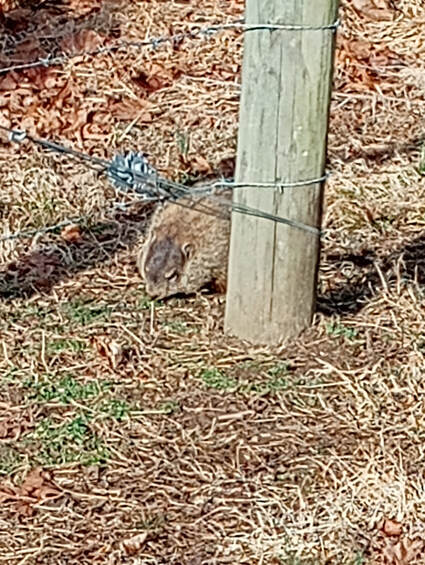 Groundhog; Photo: Charlene Uhl Groundhog; Photo: Charlene Uhl One of the most valuable techniques that I learned from a fellow ORMN birder – Lynne Leaper – is to make regular stops during your bird walk. Stop on a regular basis and just watch and listen. Lynne recommended 5 to 15 minutes and I have found this technique to be an amazingly effective way to see more birds and other animals in nature. On September 4th of last year, I was standing at one of the fence lines on our property. I regularly put a small amount of seed on the top of the fence posts and scatter some on the ground to attract birds. All the seed is usually eaten within 10-15 minutes and I move on. On this morning as I was standing very still and observing the birds, I saw something move to my right. It was a small, immature groundhog which had come out of nearby undergrowth. It may have been drawn to the bird activity. Since they also have a keen sense of smell, it may have smelt the seed. It cautiously walked to the scattered seed and began to eat. My slightest movement, however, sent it scurrying back into the thick brush. After several weeks of this behavior the groundhog became acclimatized to my presence and associated it with a food source. For the next month and a half, it came almost every day. October 17th was the last day I saw it. Since groundhogs have a lot of predators (including hawks, foxes, and coyotes, all of which we have seen on our property), I assumed it had been killed and eaten. Then this morning the groundhog appeared – over three months since I last recorded its presence – and started to eat seed just as it had last fall. It was a little more skittish but not like its first few weeks last fall. Apparently this groundhog had been hibernating and is just now coming out of its burrow. What I found after researching is that groundhogs, while primarily herbivores, are opportunistic eaters and will actually eat small birds. They can also climb trees! I have seen this more than once here on our farm. I look forward to journaling many more interesting observations during my morning bird walk. Birding tip of the day: Keep a written journal so you can look back and find information on birds’ behavior (when and if they migrated into or out of your area) and the behavior of other animals that are a part of the habitat. It will prompt you to use your observations to do research and learn more about your own property. I also record weather (cloud cover, air temperature, chill factor and humidity). I note if there is dew, frost, or snow on the ground and any other unique things (i.e. the date our field is cut, raked, and bailed). I started journaling during Basic Training Class and have found my observations to be an invaluable and specialized source for information on the natural world right here on our farm. Happy birding! Charlene Uhl 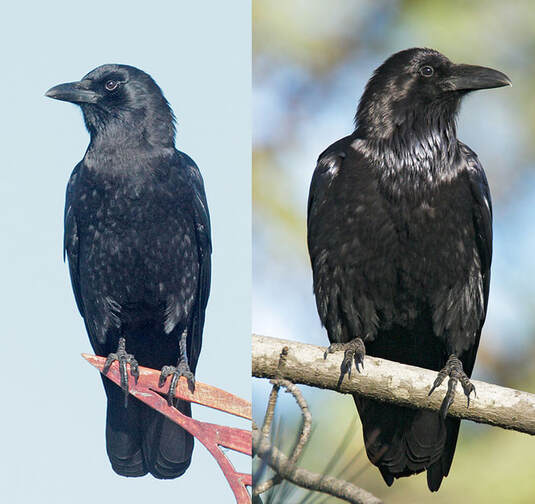 Crow (l) and raven (r); Photo: Tom Grey from BirdNote Crow (l) and raven (r); Photo: Tom Grey from BirdNote Sycamore Grove Farm, Madison County Some of my favorite birds to see (and hear) are ravens and their “cousins” the fish and common crow. The morning of 1/29/23, I was treated to a small flock of eleven fish crows flying along our farm’s southern border. Fish crows can be mistaken for the common crow – until you hear their call. It’s a nasal version of the crow call and once you hear it, you will always know which crow you’re seeing. And wait until you see the “big boy” of the group: the Common Raven. It’s a special treat to have this species visit our farm, which it does every several weeks or so. But our crow population is very territorial. If they spot a raven, they tend to hassle their larger “cousin” until it leaves the area. Listen to a fun podcast discussion “Ravens and Crows – Who’s Who?" from BirdNote https://www.birdnote.org/listen/shows/ravens-and-crows-whos-who Sycamore Grove Farm, Madison County I have always been an “outside” person – playing outside until my mother made me come in when it got dark. One of the favorite things about being outside was the birds! I grew up in Central California (way before the area where we farmed was called Silicon Valley). I became really focused on learning how to identify birds while completing my Bachelors in Biology in Illinois. Excited to share my new-found “expertise” with my family, you can imagine my chagrin when I found out that many of the birds that I observed in the Midwest didn’t live in California. The Rocky Mountains are a formidable natural barrier. Some bird guides (notably Sibley Guides) are specific to birds east of or west of this mountain range. Fast-forward fifty years: my husband and I have a 25-acre farm in Central Virginia that we named Sycamore Grove Farm for all the beautiful sycamores that grow along our borders. The majority of our land is a hay field, which attracts a lot of different kinds of birds: hawks, crows, and blue jays are numerous. We see eastern meadowlarks throughout the year. Three sides of the farm are 50-foot tall cedar trees that rooted from old cedar fence posts. These trees attract cedar waxwings and robins who feast on their berries. We also have a wonderful variety of woodpeckers including the Hairy and Downy woodies, red-bellied and red-headed woodpeckers, northern flickers and several pileated woodpeckers whose silhouette definitely show that birds are the only surviving dinosaurs. Check out a fascinating animated video “Why are birds the only surviving dinosaurs?” on the Natural History Museum website. This museum is based in South Kensington, London and Tring, Hertfordshire in the United Kingdom. I bird every morning and report my observations on The Cornell Laboratory or Ornithology’s eBird site. Their website (https://ebird.org/home) offers great information on everything about birding: how to identify birds, finding “hotspots” near you (it’s an honor to be listed among my county’s “Top Birders”), and seeing what birds to expect throughout the year in any region or location. 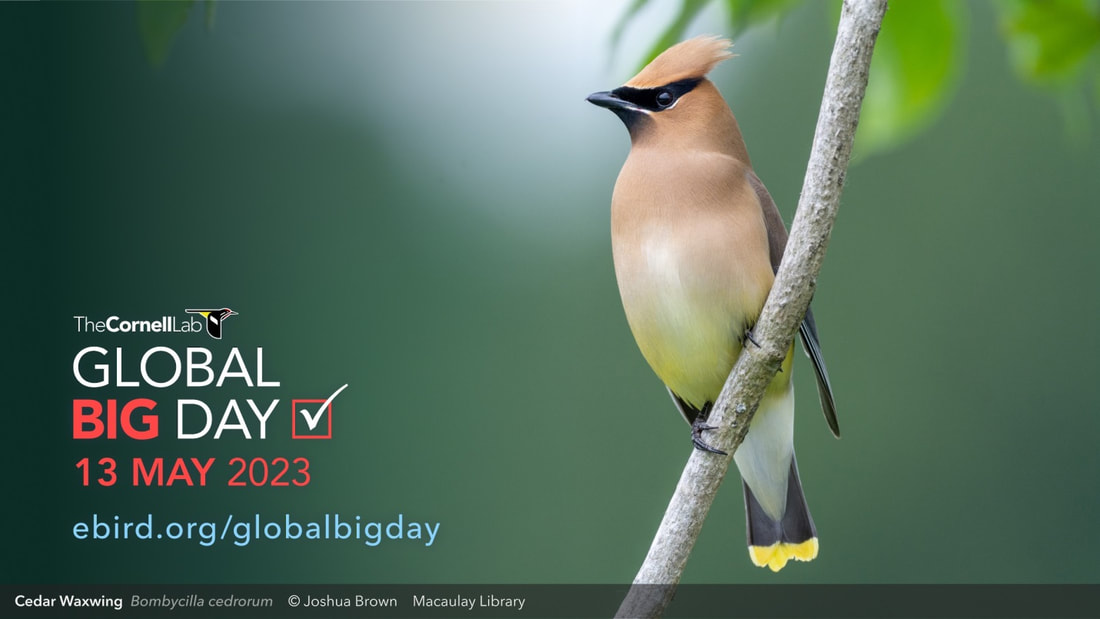 White-breasted nuthatch enjoying a snack; Photo: Charlene Uhl White-breasted nuthatch enjoying a snack; Photo: Charlene Uhl I plan to share some of my special birding experiences in this blog. And I invite you to jump in and share your experiences as well. Birders always love to hear stories about that special sighting – so please join me with your stories and I hope you enjoy mine.
Happy birding! Charlene Uhl 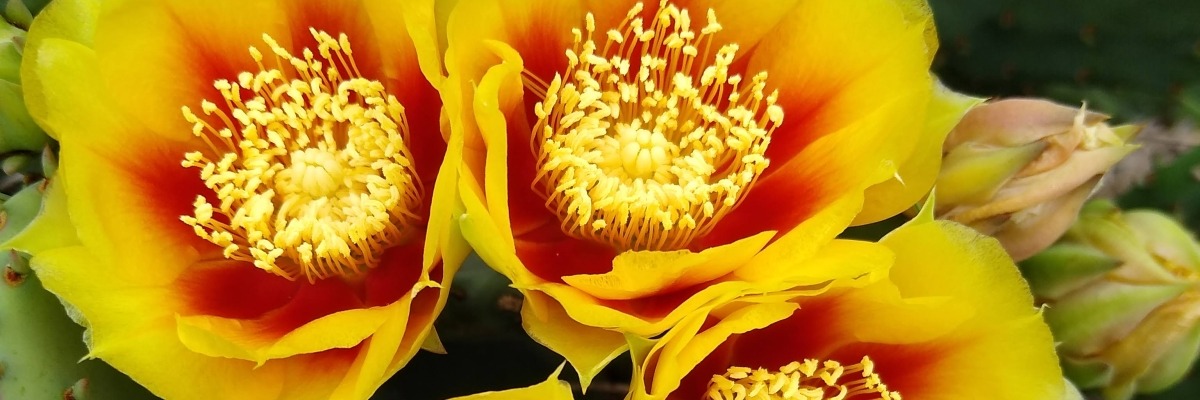 Photo: Blandy Experimental Farm Photo: Blandy Experimental Farm I enjoy the surprise of blooms in my garden each year and always add new native species. Last fall, I received two eastern prickly pears (Opuntia humifusa) from a fellow gardener. I planted both cacti in a “problem” area of my garden. The area is shaded, gritty, stays dry and reminds me of a mini “Sahara.” In the past, anything planted there had shriveled and died. I hadn’t realized that Virginia had a native cactus and wasn’t sure if it would endure Virginia’s winter. The addition of the spiny plant led to many other discoveries. While taking a walk in July, I noticed a greenish-yellow round bud on the top of my eastern prickly pear. I watched in anticipation, waiting for that ultimate burst of color. I had seen patches of eastern prickly pears at Blandy Experimental Farm, the State Arboretum of Virginia, but had never seen one in bloom. I was not disappointed when the bud burst open to display a bright yellow flower with seven sepals, one pistil, seven or more petals, and many stamens. The center was an orange hue, and the petals were heart-shaped with a single point on each end. I had no idea that the cactus bloom would be so radiant and beautiful. I was interested in learning more about the plant and began to research. For months there was no growth. I can only guess that it was establishing its root system. Winter came and my cacti retreated, turning wrinkly and slightly yellowed. I continued to worry that it would not survive the harsh winter temperatures and the snow. But in spring, it came back to life and was once again bluish-green with a matted waxy sheen. It grew taller and added new sessile pads; it now has six. The pads have air pores called areoles that are arranged in a diagonal row pattern. Each areole has a small tuft of sharp bristles called glochids that develops a sharp spine. The thorns are deciduous, help to shade the cactus's flesh, and help the cactus retain water. In discovering more about the plant, I found that the eastern prickly pear is in the Cactaceae family. The genus name, Opuntia, is pronounced ō-pun′shi-a. The origin of the term Opuntia was coined by Pliny (AD 23-79) and it is thought that the name refers to the Greek town of Opus, where a cactus-like plant grew. Humifusa is derived from a fusion of the Greek words “humus” meaning soil or earth and the word “fusus” meaning to spread. To remember the Latin name Opuntia, I visualize the pad of the cactus rounded like the O with spines. The cacti can grow up to two feet tall. The flowers can grow to be 2 to 3 inches wide and bloom from May to July. The flower is a golden yellow with a bright orange center. After the bloom is spent, it is replaced by an edible fruit full of seeds. The fruits are called cactus figs or tunas. The prickly pear genus originated in South America. The fruit is often eaten by small mammals that help to disperse the seed. The seeds were carried in the gut of small and large animals when the land was bridged between the northern and southern continents around three million years ago. The animals that spread the seed in their dung include deer, squirrel, rabbit, skunk, coyote, fox, turkey, and turtle. Pollinators are attracted to the plant, particularly native bees. Both long-tongued and short-tongued bees visit the flowers, including bumblebees, the large carpenter bee (Xylocopa virginica), digger bees (Melissodes spp.), leaf-cutting bees (Megachile spp.), halictid bees (including green metallic bees), and plasterer bees (Colletes spp.). Long-tongued bees suck nectar or collect pollen, while short-tongued bees collect pollen only; the larger bees are more likely to cause cross-pollination. An amazing adaptation of the eastern prickly pear was noted by Charles Darwin. He recognized that the cacti have thigmotactic anthers that curl over and deposit their pollen when touched. This movement can be seen by gently poking the anthers of an open Opuntia flower. I recommend watching the video at https://awkwardbotany.com/tag/opuntia/. The sensory movement is fantastical and unexpected. Historical literature shows that the plant was used in many ways. There are recipes for jellies, pickled cacti, candies, drinks and more. The fruit’s taste is reminiscent of watermelon and the plant is rich in Vitamin C and antioxidants that are an excellent source of energy for humans and wildlife. A practical use for the plant includes the use of the spines as needles for sewing. In Latin America, small insects that infest the plant were collected to make a bright red dye. Currently, the medicinal uses of the plant are under investigation. The research includes the uses of the plant in treating type 2 diabetes, obesity, high cholesterol, alcohol hangovers, colitis, diarrhea, benign prostatic hypertrophy, and viral infections. Prickly pear cactus contains fiber and pectin which can lower blood glucose by decreasing the absorption of sugar in the stomach and intestine. The “prickly” has proven to be a favorite in my native garden as it is a treasure of ever-unfolding uses and beauty. Stamen Movement in Opuntia Flower. Awkward Botany. YouTube. June 7, 2015. Retrieved https://awkwardbotany.com/tag/opuntia/. “Ozarkedgewildflowers.com.” ozarkedgewildflowerscom. Accessed June 15, 2021. https://ozarkedgewildflowers.com/summer-wildflowers/prickly-pear-cactus-opuntia-humifusa/#:~:text=Humifusa%20is%20derived%20from%20a,the%20cactus%20family%20(Cactaceae). “DiscoveringLewis & Clark.” Lewis uses a sextant while Clark records observations in a journal. Accessed June 15, 2021. http://www.lewis-clark.org/article/3120. Eastern Prickly Pear (Opuntia humifusa). Accessed June 15, 2021. https://www.illinoiswildflowers.info/prairie/plantx/prickly_pearx.htm. Chesapeake Bay Program. Prickly Pear, Opuntia humifusa. Retrieved https://www.chesapeakebay.net/discover/field-guide/entry/prickly_pear. “The Biogeographical History of the Prickly Pear Cactus (Opuntia Sp.).” GeorgiaBeforePeople, July 8, 2016. https://markgelbart.wordpress.com/2013/03/18/the-biogeographical-history-of-the-prickly-pear-cactus-opuntia-sp/. |
Have a blog or blog idea?
Let us know (click) Other Blogs
VA Native Plant Society - click Brenda Clement Jones - click John Muir Laws' Blog - click Megan's Nature Nook - click Categories
All
Archives
September 2023
Blog Administrator:
Kathleen A. VMN since 2018 |
